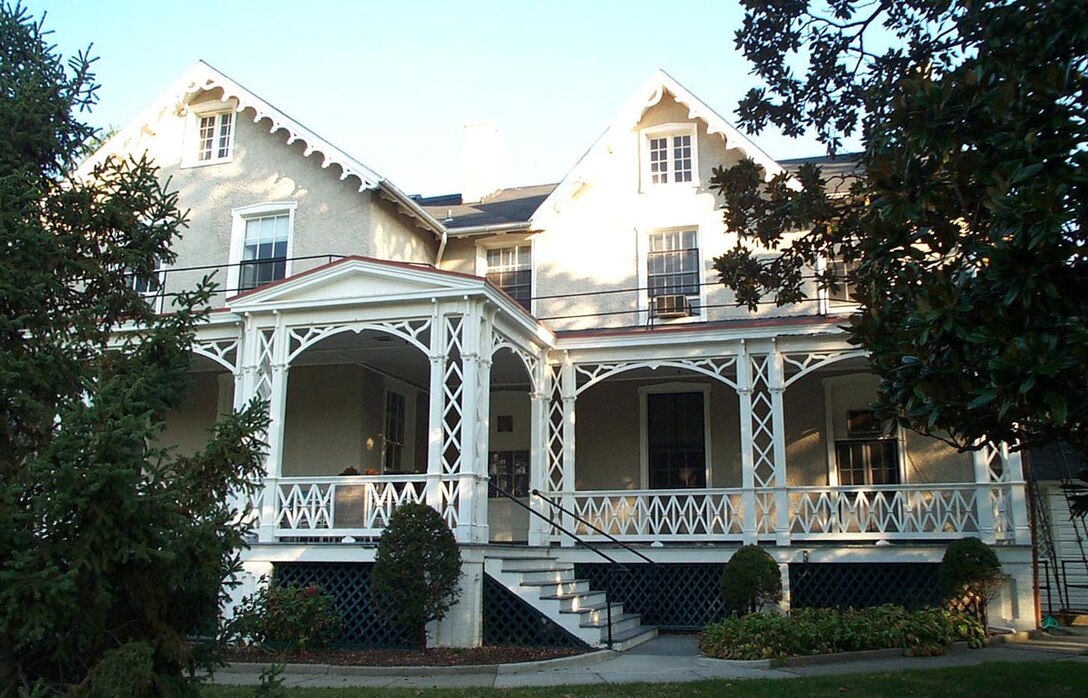Ed. Note: Earlier this month we learned the sad news that long-time friend of the Cottage and Armed Forces Retirement Home (AFRH) resident Ray Colvard passed away. Ray was active in the AFRH community, writing for The Bugler and The Communicator, two publications AFRH produced. A huge history buff, Ray focused on the history of the grounds. His office was even located where the Cottage staff library is today and his room at AFRH overlooked the Cottage. In his memory, we’re re-publishing a piece he wrote in the October 25, 1996 edition of The Bugler.

The Anderson Cottage as it looked prior to restoration to the Lincoln era
“Historic Anderson Cottage Still Stands: No Thanks to Turn-of-the-Century General”
By Ray Colvard, Associate Editor
The Bugler, October 25, 1996
History buffs have always played the game of “what if.” Yet in looking over the historical documents of the Home, one “what if,” came remarkably close to a “done deal.” Records show that Anderson Cottage [now President Lincoln’s Cottage] came perilously close to being demolished at the turn of the century.
Erected by George Riggs in the 1840s, Anderson Cottage is the oldest and most historic building at the USSAH. However, it was not until 1974 that the building was placed on the Historical Register and was given any measure of protection.
The Annual Report of 1901 told of the “alarming” plan to demolish the Anderson Building, so that a larger building could be erected on the site. As the Report states, it was a pity that such a thought could have been entertained “even for a moment.”
The Report continued at length to point out the historic and traditional importance of Anderson Cottage and to state that the building was “carefully preserved and revered by all.” The writer of the Report should have stated, perhaps, that the building “ought to be revered by all.” One individual certainly did not share the sentiment expressed in the Report.
Lt. Gen. Miles, commanding the U.S. Army, and thus the Chairman of the Board of Commissioners for the Home, seemed to have commissioned himself as a one-man bulldozer in respect to Anderson Cottage. He called a meeting of the Board, in his office, on the 12th of June, 1901, to approve plans for a building “to be erected on the present site of the Anderson Building.” The plans were approved, but it would seem, some members of the Board had crossed their fingers when they voted. Officers might find it difficult to openly disregard the opinion of the Army’s commandant.
Away from the General, Board members continued to consider other sites for new buildings. Two years later, they voted to build what is now the Grant Building–but on its present site. This did not please General Miles. He demanded that the Board adhere to the earlier vote and demolish Anderson Cottage.
On the 17th of April 1903, the Board met and voted. Four members voted to retain Anderson Cottage and two to demolish it. But the General was persistent and called for a new meeting when he could present his argument. A month later Gen. Miles gave his argument:
The architects’ plans that had been accepted were unsuitable. The building plans did not include verandas. The was no place for residents to walk or exercise. The building as planned would resemble a prison, not a comfortable home. Should the building be set at the far corner of the home, occupants would be isolated from activities, and would not be able to view the city (the Sherman building was in front of it). Having graveyards so close to a domicile would create a depressing atmosphere. “It would be an unnecessary hardship upon the brave men who would obligated to occupant the building.”
As for Anderson Cottage, Gen. Miles aid, “it was old.” It could not be considered a “sacred trust” since the Lincoln occupancy was minimal, and besides, former Boards had taken out and given away any furniture associate with Lincoln. The building was virtually unused. It was occupied by a few band members. The site now serving a few, could serve hundreds better.
The General’s remarks were entered in the minutes and the Board voted to keep the Anderson Cottage. The Secretary of War concurred. The General, himself, got into the “what if,” mode by asking, “What if Anderson Cottage were moved off its site to a less prominent place to free the site for another more appropriate building?” No Board member, it seemed, cared to play the “what if” with him.
